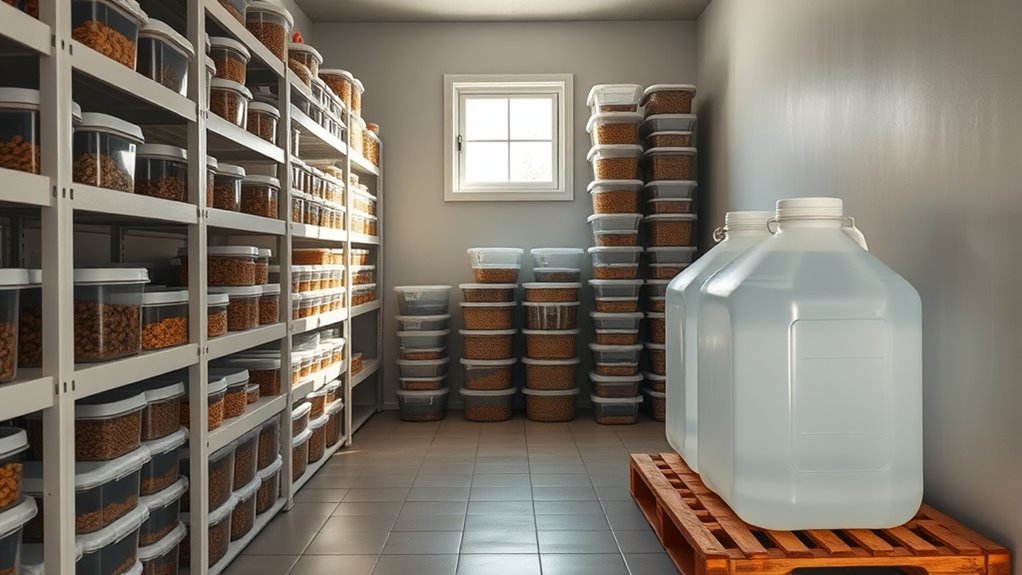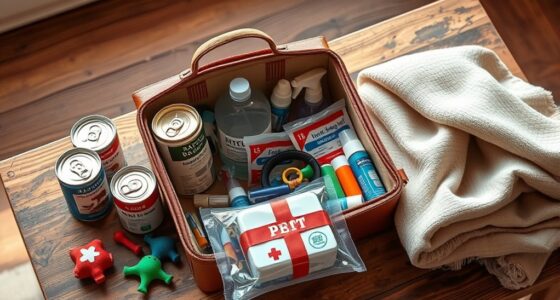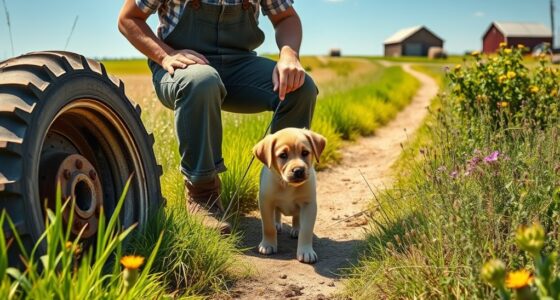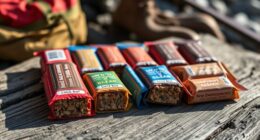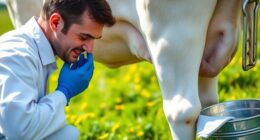To stockpile pet food and water safely, check expiration dates regularly and rotate supplies to keep everything fresh. Store food in airtight, food-grade containers in a cool, dry place away from sunlight, and use stackable containers to save space. Replace stored water every six months and keep it in clean, sealed containers in shaded areas. Proper organization and maintenance make certain your pets stay safe and healthy—learn more about best practices to prepare effectively.
Key Takeaways
- Check and adhere to expiration dates, rotating stock to use older supplies first.
- Store pet food in airtight, food-grade containers in a cool, dry, shaded area.
- Use clean, food-grade containers for water, replacing stored water every six months.
- Organize supplies with stackable containers for easy access and space efficiency.
- Regularly inspect all supplies for spoilage, pests, and proper condition to ensure safety.

Stockpiling pet food and water is essential for ensuring your pets stay safe during emergencies, but doing so improperly can lead to health risks. One of the most important aspects is paying attention to expiration dates. Pet food, like human food, has a shelf life, and consuming expired products can cause health issues such as digestive upset or nutritional deficiencies. Regularly check the expiration dates on your stored supplies and rotate your stock, using the oldest items first to prevent waste and ensure freshness. This practice helps you avoid feeding your pets compromised food that might contain spoiled ingredients or lose its nutritional value over time.
Equally important is the choice of storage containers. You want containers that are airtight, sturdy, and made from food-grade materials to prevent contamination and spoilage. Using improper containers, such as those that are porous or not designed for food storage, can lead to exposure to moisture, pests, or bacteria, all of which threaten your pet’s health. Clear containers with secure lids are ideal because they allow you to visually monitor the contents and quickly spot any signs of spoilage or pests. Store these containers in a cool, dry place away from direct sunlight, which can degrade the quality of the food and water over time. Proper storage not only extends the lifespan of your supplies but also keeps them safe from pests and environmental factors.
When it comes to water, the same rules apply. Use clean, food-grade containers to store water for your pets, and make sure to replace the water regularly—ideally every six months—to prevent bacterial growth. Label your water containers with the date of storage, so you know when it needs to be replenished. Keep water in a cool, shaded area to prevent algae growth or contamination. For pet food, consider using stackable containers that fit neatly in your storage space, making it easier to organize and access supplies quickly during an emergency. This organization helps you maintain a consistent rotation schedule, ensuring your pets always have access to fresh, safe food and water. Additionally, being aware of pet food shelf life and storage best practices can help you maximize the safety and longevity of your supplies.
Frequently Asked Questions
How Long Can Pet Food Be Safely Stored Before It Expires?
Pet food typically stays safe for 6 months to a year past its shelf life if stored properly. To maximize freshness, follow storage tips like keeping it in a cool, dry place and airtight containers. Check expiration dates regularly, and discard any food that smells off or looks moldy. Proper storage guarantees your pet’s food remains nutritious and safe, helping you avoid waste and unexpected health issues.
What Are Signs of Spoiled Pet Water or Food?
Think of spoiled pet water or food as a ticking time bomb. You’ll notice signs of deterioration like a foul smell, slimy texture, or mold growth. Discoloration or a change in appearance also warns you that it’s no longer safe. If your pet refuses to eat or drink, trust their instincts. Always check for these signs before giving your pet food or water to prevent health issues.
Can I Mix Different Brands of Pet Food in Storage?
Yes, you can mix different brands of pet food in storage, but focus on brand compatibility to avoid any adverse reactions or digestion issues. Use airtight storage container options to keep the food fresh and prevent contamination. Make sure to label containers clearly and store them in a cool, dry place. Regularly check for spoilage signs, and only mix what you plan to feed soon to maintain quality and safety.
How Should I Store Pet Food for Multiple Types of Pets?
You should carefully organize your pet food storage to prevent mishaps. Use proper storage containers to keep each type fresh and avoid cross-contamination. Label and separate containers clearly for each pet, and store them in a cool, dry place. This way, you safeguard your pets’ health and make certain you always have the right food ready. Don’t underestimate the importance of organization—small details make a big difference.
What Are Best Practices for Rotating Stock to Prevent Waste?
To prevent waste, regularly rotate your pet food stock by checking expiration dates and using older supplies first. Store food in airtight storage containers to maintain freshness and prevent spoilage. When you bring in new supplies, place them behind older items. This way, you’ll guarantee your pets always eat fresh food, minimize waste, and make the most of your stockpile. Remember to discard expired or spoiled food promptly.
Conclusion
By stockpiling pet food and water carefully, you’re like a cautious gardener preparing for a storm—anticipating and protecting what matters most. Remember, just as a gardener checks supplies before a storm, regularly review and rotate your supplies to keep them fresh. A neighbor once kept emergency water for her dog, only to find it was still good months later. Your preparedness can turn uncertainty into peace of mind, safeguarding your pet’s well-being when it’s needed most.

